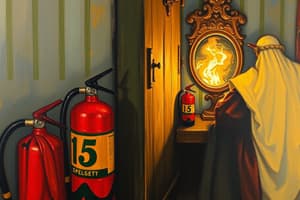Podcast
Questions and Answers
What is the primary purpose of using dry chemical fire extinguishers in engine rooms?
What is the primary purpose of using dry chemical fire extinguishers in engine rooms?
- To increase the intensity of the fire
- To cover the fire surface completely and prevent oxygen from reaching it (correct)
- To create a barrier between the fire and flammable liquids
- To cool down the fire temperature
Why is it crucial to choose the right type of fire extinguisher for each specific fire classification?
Why is it crucial to choose the right type of fire extinguisher for each specific fire classification?
- To ensure the most effective suppression of the fire based on its nature (correct)
- To increase the cost-effectiveness of extinguishing the fire
- To reduce the weight of the extinguisher for easier handling
- To avoid causing additional damage to the engine room
When operating a portable fire extinguisher, where should you aim the nozzle?
When operating a portable fire extinguisher, where should you aim the nozzle?
- Directly at people to keep them away from the fire
- At the top of the flames
- Towards the base of the fire, away from people, property, and other heat sources (correct)
- At any nearby fuel containers to prevent further combustion
What is the purpose of tilting the extinguisher upright after use?
What is the purpose of tilting the extinguisher upright after use?
Why is squeezing the handle slowly while maintaining aim important when using a portable fire extinguisher?
Why is squeezing the handle slowly while maintaining aim important when using a portable fire extinguisher?
In what situation should you keep squeezing the handle of a portable fire extinguisher until it empties?
In what situation should you keep squeezing the handle of a portable fire extinguisher until it empties?
What is a key benefit of regular drills and exercises for crew members in relation to fire extinguishers?
What is a key benefit of regular drills and exercises for crew members in relation to fire extinguishers?
What is the primary purpose of automatic fire detection systems in engine rooms?
What is the primary purpose of automatic fire detection systems in engine rooms?
What do alarm signals from automatic fire detection systems in engine rooms mainly rely on to alert crew members?
What do alarm signals from automatic fire detection systems in engine rooms mainly rely on to alert crew members?
Why is it crucial for crew members to understand how alarm signals from fire detection systems work?
Why is it crucial for crew members to understand how alarm signals from fire detection systems work?
What is a significant outcome of the successful implementation of fire extinguishing equipment in response to large-scale fires?
What is a significant outcome of the successful implementation of fire extinguishing equipment in response to large-scale fires?
Why is proper training considered essential for the efficient operation of fire extinguishers during emergencies?
Why is proper training considered essential for the efficient operation of fire extinguishers during emergencies?
Flashcards are hidden until you start studying
Study Notes
Usage of Fire Extinguishing Equipment in Engine Room Response to Large-Scale Fires
Large-scale fires in engine rooms pose significant risks to ships and their crew members. In such situations, timely and effective utilization of fire extinguishing equipment is crucial. This section elaborates on the strategies for using these essential tools during an emergency.
Types of Fire Extinguishers for Engine Rooms
There are several types of portable fire extinguishers suitable for engine rooms, including those with foam, carbon dioxide, dry chemical, wet chemical, and water contents. For instance, dry chemical extinguishers can smother the fire by covering its entire surface while preventing oxygen from reaching it. However, care must be taken when choosing the right type of extinguisher for each specific fire classification.
Procedure for Operating Portable Fire Extinguishers
The correct procedure for operating portable fire extinguishers includes these steps:
- Pull out the safety pin, which holds the lever down that releases the extinguishing agent.
- Aim the nozzle towards the base of the fire, away from people, property, and other heat sources.
- Squeeze the handle slowly while maintaining aim. If the fire does not go out, keep squeezing until the extinguisher empties.
- Tilt the extinguisher upright after use, reset if necessary, and return it to the designated storage area.
Training for Using Fire Extinguishers
Proper training is essential for efficient operation of fire extinguishers during emergencies. Crew members should be familiar with various types of extinguishers, their safe handling procedures, and proper techniques for applying them. Regular drills and exercises can help prepare personnel for real-life scenarios and enhance their confidence in utilizing fire extinguishers effectively.
Fire Detection Systems and Alarm Signals
Engine rooms often have automatic fire detection systems that continuously monitor the space for signs of fire. These systems may trigger alarm signals either by sound (visual alarms) or by displaying relevant instructions on screens throughout the ship. It is crucial for all crew members to understand how these warnings work and what actions they should take upon receiving them.
In summary, the successful implementation of fire extinguishing equipment in response to large-scale fires requires careful selection, proper training, and prompt deployment. By following established protocols and remaining vigilant, engine room staff can significantly reduce the impact of devastating blazes on their vessels and passengers.
Studying That Suits You
Use AI to generate personalized quizzes and flashcards to suit your learning preferences.




